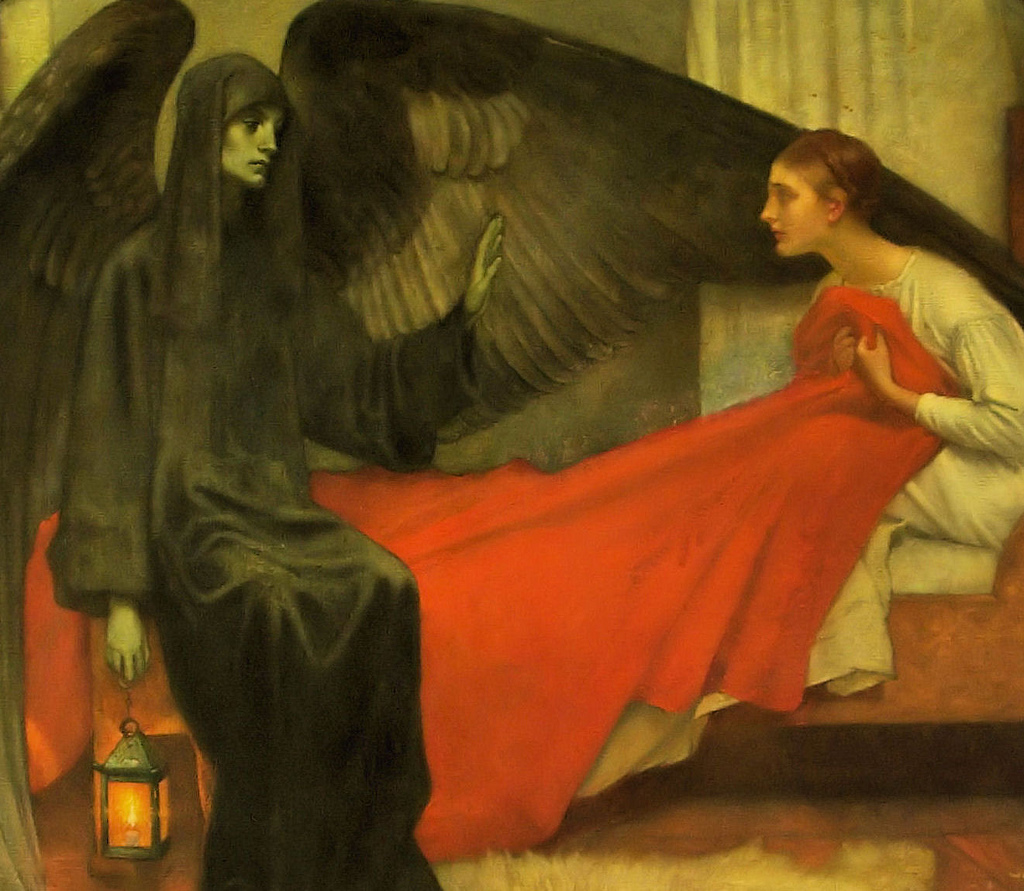
I don’t consider myself to be someone easily seduced, much less by Death, but Schubert’s “Death and the Maiden” sears a haunting image on my psyche that has few equals in music. (One of them being, ironically, another Schubert piece, his Impromptu No. 3 that I blogged about HERE. And, okay, Debussy’s “Afternoon of a Faun”).
I’ve enjoyed listening to “Death and the Maiden,” Schubert’s Quartet No. 14 in D minor, for decades. In recent years, however, I’ve been so drawn to the second movement, I’ll listen to the first and second movements and skip the rest. (Shh, don’t tell any music purists!) I knew the second movement was based on the eponymous song Schubert wrote seven years earlier, in 1817, but it’s become increasingly clear just how much it stands out from the rest of the quartet. Much in the way Samuel Barber’s “Adagio for Strings” is merely one movement of his 1936 string quartet but vastly upstaged the rest after he arranged the movement for stringed orchestra. (Ooh, another interesting blog!)
The second movement tells such a vivid story, which of course appeals to the storyteller in me, as well as the reader who loves immersing herself in stories. But is it morbid to love a story where Death comes to visit a young woman who’s terrified by his presence and its implications?
Maybe you don’t know a thing about the story. So, let’s backtrack. The song came before the string quartet, after all. And the poem, by Matthias Claudius (1740-1815), came before that. So. Here’s an excerpt of Claudius’ two-part poem, translated from its original German into English, and be aware that German-to-English translation is open to personal interpretation sometimes, because the Germans have a word for everything, and then some.
Das Mädchen (The Maiden)
Vorüber, ach vorüber. (Pass by, oh pass by!)
Geh, wilder Knochenmann! (Go, you savage skeleton!)
Ich bin noch jung, geh Lieber! (I am still young, go, dear!)
Und rühre mich nicht an. (And do not touch me.)
Der Tod (Death)
Gib deine Hand, du schön und zart Gebild! (Give me your hand, you fair and tender form.)
Bin Freund und komme nicht zu strafen. (I am a friend and come not to punish.)
Sei gutes Muts! ich bin nicht wild. (Be of good cheer! I am not savage.)
Sollst sanft in meinem Armen Schlafen! (Gently in my arms shall you sleep.)
Here’s a rendition of the song the 20-year-old Schubert wrote in 1817, based on the poem. It features Dietrich Fischer-Dieskau (piano) and singer Júlia Várady. (But it might only be the first verses and not the ones above.)
A little bit about the composer. I detailed personal information about Schubert HERE, so I won’t repeat myself, but it bears reiterating that in 1822, the now-successful, well-received Schubert contracted syphilis, which would go on to destroy his health, his good spirits and ultimately his life. It was during this period of decline that he created his Quartet No. 14, slotting “Death and the Maiden” into the quartet’s second movement. He was in a much gloomier place in life, he confessed in a March 1824 letter to his friend, Leopold Kupelwieser.
“I find myself to be the most unhappy and wretched creature in the world. Imagine a man whose health will never be right again, and who in sheer despair continually makes things worse and worse instead of better; imagine a man, I say, whose most brilliant hopes have perished, to whom the felicity of love and friendship have nothing to offer but pain at best, whom enthusiasm (at least of the stimulating variety) for all things beautiful threatens to forsake, and I ask you, is he not a miserable, unhappy being? ‘My peace is gone, my heart is sore, I shall find it nevermore,’ I might as well sing every day now, for upon retiring to bed each night I hope that I may not wake again, and each morning only recalls yesterday’s grief.”
And yet, his Quartet No. 14, “Death and the Maiden,” came from that place. Which, to me, explains how, and why, the quartet has such power. And, as you’ll come to hear, it’s a world apart from his 1817 song. The second movement of the quartet is nuanced, mysterious, heartbreaking, and, curiously, utterly seductive, with its two distinct voices. And, surely, far more personal to Schubert than the song had been. Because now, battling illness, depression, the realities of an illness that gets treated with mercury, whereby you either die by syphilis or mercury poisoning, Schubert gets it.
It’s not just the maiden that Death is after. It’s Schubert.
Here’s the Borromeo Quartet (Nicholas Kitchen and Kristopher Tong, violins; Mai Motobuchi, viola; Yeesun Kim, cello) in a fabulous rendition I recommend watching several times in a row so that you can 1) fully enjoy the music; 2) admire the story that is so viscerally and effectively delivered; 3) watch four talented musicians interact so as to create a rich, seamless sound and intention; 4) go back to enjoying music+story with your eyes shut.
Is it just me, or can you see her, this maiden? I imagine her, a pretty young woman, pink cheeks and sunny disposition, a lilt to her steps as she attends to her tasks, humming, smiling, pausing to inhale the scent of flowers spilling out of a vase. She is lovely and lithe; she is life itself. Without ever actually seeing her, I have fallen in love.
And then Death shows up.
But the music never turns ugly. That’s the skillful part. I can feel the dreadful conflict, the flinching from death, the continued sweetness of the maiden heard through the first violin’s voice. All that innocence and purity, up against Death. We all know how this will turn out. The Grim Reaper, skeletal and terrifying, clad in black flowing robes and clutching a scythe, is the seducer, not the seduced, after all.
If I were watching this in a movie, around this time, I would turn away from the screen. But Schubert gives the story a twist. The maiden stops fighting. She gives in to Death’s low, soothing voice. You can hear this in the music. The composition is in D minor, which is appropriately funereal and suits Death perfectly. But toward the end, when the maiden stops fighting Death and capitulates, the music switches from D minor to D major.
It changes everything. Just as, in life, looking death in the eye, with acceptance, with loss of fear, changes everything. There is even a certain grace, a nobility, in the closing phrases of the second movement, that seems so true to life — or death, in this case — that it gives me little prickles down the neck and makes me feel like I’m witnessing something transcendent.
So, let me know, reader. Am I morbid in finding this to be one of the most compelling, soulful, profound, irresistible pieces of classical music? Or do you feel it too?
And for those of you new to this quartet composition, thinking — wait! Where’s the rest of the quartet? — here you go. Featuring the Eliot Quartet (Maryana Osipova, Alex Sachs, violins; Dmitry Hahalin, viola, Michael Preuß, cello.


I feel it too!
Yay, Jess! Thanks for chiming in!
I can too!
Ooh, we are now a quorum! Thanks for joining in on the conversation, PG Greaves!
Returning to muse about why on earth I chose the word quorum. After I posted the previous message, I paused and realized I wasn’t absolutely, 100% sure what it meant. Since I am a professional wordsmith, I went off and Googled it and, like always, found the definition fascinating. Am now wondering if this is something odd about me, that I adore dictionaries and reading the definitions of pretty much any word. I’m guessing it’s a writer (or voracious reader) thing.
And since maybe you’re scratching your head too over what quorum means, well, here you go!
A quorum is the minimum number of members of a deliberative assembly necessary to conduct the business of that group. According to Robert’s Rules of Order Newly Revised, the “requirement for a quorum is protection against totally unrepresentative action in the name of the body by an unduly small number of persons.”
I actually find the Schubert cello quintet even more like you describe–seductive and deadly. It was one of the last, if not the last, piece Schubert wrote, and he never saw it performed. He must have felt death right around the corner as he was writing. And yet it is still about the struggle, about beauty, and the affirmation of life.
Karen, this is so interesting! I’ve always seen [part of] the adagio music as something soothing and loving. Because of a movie, LOL. Three Men and a Baby, although I can’t remember if it was the French version or the Hollywood version. Anyway, the three men rock the baby to sleep through the soothing portion of the adagio and it’s sublime. But now that I read your comments here, I’ll have to give the whole quintet a listen again. I absolutely love this composition. And you just now taught me that it’s also referred to as “the cello quintet.” Cool – a new classical music factoid!
I hadn’t thought of it as a lullaby–which part? The 3rd movement? There is a gorgeous duet between the viola (me!) and cello 2 in that movement that I could imagine soothing a baby to sleep. The second movement of the quintet really reminds be of both the struggle and the eventual acceptance of the transience of life. It starts out with a gorgeous melody, and then there is a really difficult middle section, with dueling rhythms between the inner and outer voices, that seems all about life’s struggles and conflicts, and then the first section’s melody comes back in the violin I, but it’s subtly changed, and the opening melody unravels, like a sweater when the thread is pulled.
I think that quintets are generally referred to by the name of the “extra” instrument, in addition to the standard string quartet. So there are piano quintets, which are a string quartet plus a piano; clarinet quintets, string quartet plus clarinet; viola quintets, which have two violas instead of one; and cello quintets, which have two cellos instead of one.
“Lullaby” was probably the wrong word, since it only has that meaning to me, from watching the “sleeping baby” scene in the movie. No, nothing in the third movement. You mentioned it, the beautiful, slow section in the second movement, that speeds up to something frantic, but goes right back to that gentler section.
I love all that you wrote – I’m going to reread it the next time I listen to that second movement!
I saw this performed by a quartet using period instruments at St. Anne’s in Vienna, Austria. It was an other-worldly experience.
I absolutely adored this article. Thank you.
Thank you for sharing these wonderful comments, Ann!